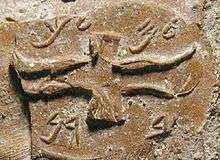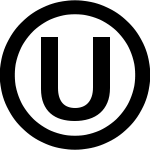Hechsher
| Hechsher | |
|---|---|
|
The hechsher of the Orthodox Union is the most widely known kosher certification in the world. | |
| Product category | Food products |
| Type of standard | Religious |
A hechsher (/hɛxʃər/; Hebrew: תעודת כשרות [ˈheχʃeʁ] "kosher approval"; plural: hechsherim) is a rabbinical product certification, qualifying items (usually foods) that conform to the requirements of halakha.
Forms
A hechsher may be a printed and signed certificate displayed at a commercial venue or on a media advertisement advising the consumer that the subjected product is Kosher. Such certificates usually display the name of the rabbinical court issuing the hechsher, the name of the business or product, date of issue, expiry date and stamp of rabbi who issued the certificate.
It may also be a certification marking on individual retail packaging of items which have been certified as Kosher. This marking is usually a basic stamp or emblem indicating the issuing rabbinical court. Modern hechsherim display sophisticated holograms and seals which are hard to forge.[1]
Types
A hechsher is typically issued for food products and is issued on non-food items such as cleaning agents and disposable cutlery which come in contact with foods certifying its ingredients as not containing any animal extracts or other halakhically prohibited substances.
The dietary laws of kashrut specify food items that may be eaten and others that are prohibited as set out in the commandments of the Torah.
Observant Jews will generally only eat permitted foods. To assist Jewish consumers, rabbinic authorities produce and regulate their own hechsherim. It is usually Orthodox rabbis who assume the jobs of mashgichim (singular: mashgiach, "supervisor"). This means that they will "supervise" the products and processes that manufacture kosher food to ensure compliance with the required standards. The mashgiach will allow the manufacturer to apply a hechsher to the packaging of the product only if found to contain only kosher ingredients and produced in accordance with halakha.
The rabbi may also apply additional words or letters after the hechsher to denote whether the product contains meat (often denoted "Meat"), dairy (D or Dairy), neither meat nor dairy (Pareve), whether the product is Kosher for Passover because it contains no chametz (P), whether the product is Pas Yisroel (bread baked at least in part by a Jew), cholov yisroel (any dairy products came from Jewish owned farms), or whether the product is yoshon (lit. "old": all grain contents took root before the previous Passover).
It is also common for rabbis to issue a hechsher on religious accessories, such as tefillin, mezuzot and tzitzit which must be produced according to specific halakhic procedures and requirements. Other items which are used for religious practice such as Four Species bear hechsher testifying that they confirm to halakhic requirements.
In Israel it is common for manufacturers of all kinds to display a hechsher on products or in commercial advertisement certifying that their production was not done during the Shabbat.
History
Seals

The Babylonian Talmud (Shabbat 21b) (תלמוד בבלי מסכת שבת דף כא/ב) cites the first example of a kashrut seal. The seal of the Kohen Gadol on jugs containing olive oil used in the Jewish Temple for the lighting of the Menorah. The Menorah has since become a symbol for purity in Jewish tradition.
'LMLK seals' (למלך) were stamped on the handles of large storage jars mostly in and around Jerusalem during the reign of King Hezekiah (circa 700 BC) based on several complete jars found in situ buried under a destruction layer caused by Sennacherib at Lachish.[2]

None of the original seals have been found, but about 2,000 impressions (also referred to as stamps) made by at least 21 seal types have been published.
The practice of marking food as a sign of kashrut can be dated back as far as the Byzantine period (6th century CE). According to archeologists, Jews of Uzah, Israel stamped their dough with impressions of the Jewish Temple Menorah whilst preparing bread, in order for consumers to verify its kashrut. One such clay stamp was discovered in an excavation near Akko in December 2011.
Dr. David Amit of the Israel Antiquities Authority, who has made a study of bread stamps explained the find; “A potter engraved the menorah image in the surface of the stamp prior to firing it in a kiln, whereas the owner’s name was engraved in the stamp’s handle after firing. Hence we can assume that a series of stamps bearing the menorah symbol were produced for Jewish bakers, and each of these bakers carved his name on the handle, which also served as a stamp.
"In this way the dough could be stamped twice before baking: once with the menorah – the general symbol of the Jewish identity of Jewish bakeries, and again with the private name of the baker in each of these bakeries, which also guaranteed the bakery’s kashrut."
Certification
An 11th-century certificate found in the Cairo Geniza written by a rabbinical court, testified the kosher status "according to rabbinic law" of the cheeses being sold by a Karaite grocer, Yefet b. Meshullam of Jerusalem. The document explains that the cheese was produced in a factory on the Mount of Olives that followed rabbinic practice.
The certificate reads: "The cheeses are kosher and it is appropriate for Rabbanite Jews to purchase them. We grant this permission only after having made a formal purchase from him and having witnessed an oath he took on the holy Torah"
It may be important to note that the Karaite and Rabbanite communities may have been theologically at odds, but often maintained good social and economic relations during the 10–13th centuries in Egypt, Palestine and Syria. It was obviously as important for the Karaite grocer to do business with Rabbanite customers as it was for the latter to be able to rely on the religious acceptability of his products.[3]
Specific authorities

In America, one of the best known hechsher symbols is the "OU" of the Orthodox Union, the world's largest kosher certification agency. As of 2010, it supervises more than 400,000 products in 8,000 plants in 80 different countries.[4]
In Britain, a widely known hechsher symbol is the "KLBD" of the London Beth Din based in London.
Other hechsher include: OK Kosher Certification based in Brooklyn, New York, Star-K based in Baltimore, Maryland, EarthKosher Kosher Certification Agency with offices in Colorado, New York and Israel, the logo of both the Johannesburg and Cape Town Beth Din used in South Africa, MK Va'ad Ha'ir[5] based in Montreal, Canada, and The Kashrut Authority[6] based in Sydney, Australia. The largest number of agencies is in the USA.
Kashrus Magazine publishes a bi-annual guide to almost all kosher supervision agencies worldwide;[7] its 2013–2014 Kosher Supervision Guide (196 pages including an index) features 1,151 agencies. A bi-annual supplement of some 32 pages is published in alternate years. The latest supplement was published in September 2013 and brought the number of agencies listed to 1,253.
Spelling
- At the 2006 Scripps National Spelling Bee, contestant Saryn Hooks correctly spelled "hechsher", but her spelling was ruled incorrect. A few minutes later, the judges realized their printed spelling of "hechscher" was incorrect and reinstated Hooks, thanks to 7th grader Lucas Brown, who noticed the error and called it to the attention of his father.
See also
- Civil laws regarding kashrut
- Hechsher Tzedek
- Kosher foods
- Taboo food and drink
- Unclean animals
- Kashrut
- Yoshon
References
- ↑ Popper, Nathaniel (24 November 2006). "Kosher Goes High Tech in Fraud Fight". The Jewish Daily Forward. Retrieved January 18, 2013.
- ↑ Ussishkin (2004), The Renewed Archaeological Excavations at Lachish, p. 89 ("As the work of the renewed excavations developed it became clear that the destruction of Level III must be assigned to Sennacherib's attack in 701 BCE.").
- ↑ http://www.genizah.org/Manuscript_Samples.aspx#_self
- ↑ Sue Fishkoff (2010). Kosher Nation. Schocken Books, New York. p. 155. ISBN 978-0-8052-4265-2.
- ↑ Jewish Community Council of Montreal
- ↑ The Kashrut Authority Website
- ↑ http://www.kashrusmagazine.com/
